| Article ID | Journal | Published Year | Pages | File Type |
|---|---|---|---|---|
| 80569 | Solar Energy Materials and Solar Cells | 2006 | 7 Pages |
Abstract
Optimization of plasma enhanced chemical vapor deposited hydrogenated silicon nitride (SiNx:H) towards bulk passivation of multi-crystalline silicon cells has been carried out for both low and high frequency (HF) plasma deposition. Experimental results showed that bulk passivation is not caused by hydrogen incorporation in the top silicon layer during deposition and subsequent diffusion towards the bulk during firing, but that it is released from the SiNx:H film. We demonstrate that the amount of passivation depends on the SiNx:H density and its resistance against etching in HF. Optimization of the density, varying deposition temperature and using hydrogen dilution resulted in an optimized passivation.
Related Topics
Physical Sciences and Engineering
Chemical Engineering
Catalysis
Authors
H.F.W. Dekkers, S. De Wolf, G. Agostinelli, F. Duerinckx, G. Beaucarne,
